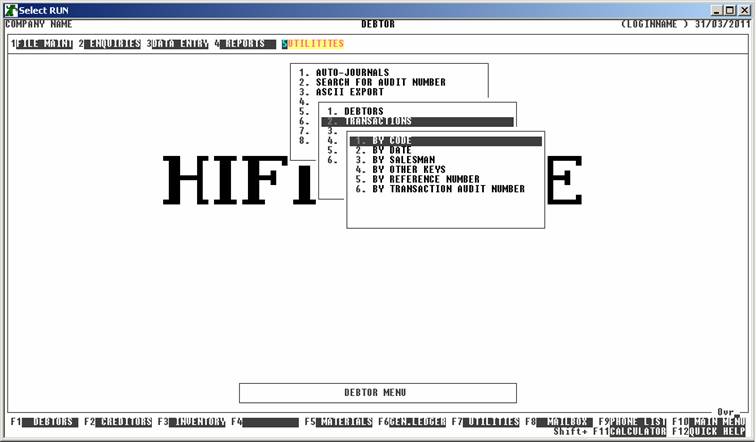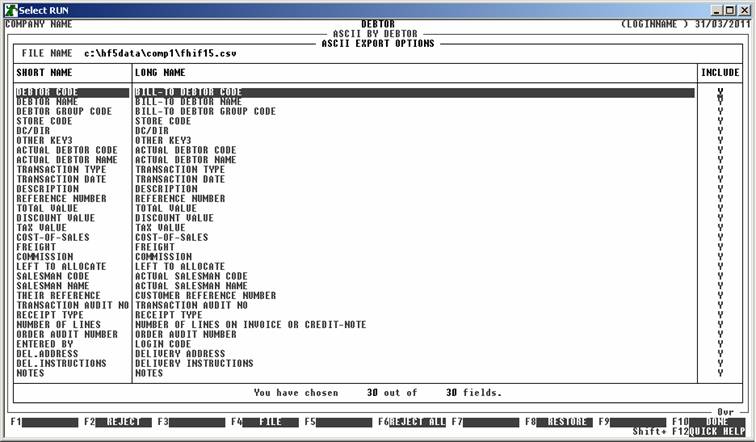HiFinance
5
SECTION
1.5.3.2 - DEBTOR TRANSACTIONS ASCII EXPORT
USAGE: To export a file detailing,
all or a subset, of the information on the Debtor transaction-file. This export
file can then be used as input to other programs, such as Spreadsheets,
Databases and Word-processors. This gives you the flexibility to format
reports, etc. in ways not otherwise available in HiFinance.
DISCUSSION: When you choose this option, the screen will
appear as follows:

Here you can choose the order in which you wish to
export the data. Choose the order you wish to export the data by pressing the
number next to the option. If you choose to print BY OTHER KEYS, another menu will open to allow you to specify
which of the three OTHER KEYS you actually require.
Hint: If you intend to limit the report to a range of
transactions, it is most efficient to export the file in the same order. Eg if
you wish to limit the file to a range of salesmen, the program will scan the
transaction-file faster if you also export the report in salesman order.
Having chosen from the options, the following
questions will appear:
UNALLOCATED TRANSACTIONS
ONLY This option is particularly useful
for picking up unpaid Invoices. If you answer Y,
HiFinance will mask any full paid transactions.
INCLUDE ALL DEBTOR
TRANSACTIONS If you do not wish to set any limits on
the report, enter Y otherwise enter N. If you enter N, you will be asked a list
of further questions.
The following question asks you to enter both a
lower and upper limit. The upper limit must not be less than the lower limit.
The default answers define the extreme limits of the field. You do not have to
change all of these limits. Only change the ones you wish to, and tab past the
others.
DEBTOR CODE RANGE This is the Debtor’s code.
SALESMAN RANGE This is the salesman code as it appears on the transaction-file (not
the Debtor master-file).
OTHER KEY RANGE This may appear as a different literal depending on how you
have defined the field in SYSTEM
PARAMETERS.
GROUP RANGE This is the Debtor Group.
TRANSACTION DATE RANGE This is the transaction date.
TRANSACTION VALUE RANGE This is the total value of the transaction.
REFERENCE RANGE This reference number, eg Invoice number.
AUDIT NUMBER RANGE This Transaction Audit Number. Printing in this order will sort
the report in the order the transactions were entered into the system
irrespective of whether a transaction was forward or backdated.
In all cases, the default answers are the extreme
limits of each range, so if you do not wish to limit the report on a particular
field, just bypass it.
INCLUDE ALL TRANSACTION
TYPES If you wish to print exclude any
transaction types, enter N here and you will be
presented with a complete list of Debtor transaction types to choose from. If
you wish to include all transaction types, simply enter Y.
Next you will be asked for the export file name and
options. A full explanation of the fields may be found in FORMATTING ASCII
EXPORT FIELDS (see SECTION B).
If you are using the export function for the first time, you are strongly
encouraged to view this section of the manual. To end this page, press <F10> or <Enter> past the last option. You will
next be presented the following screen:

This screen relates to the exact fields you wish to
export. The top of this screen displays the file name you will be exporting, as
a reminder. The centre portion of the screen displays the short name of each
field available for export. Next to this is a longer, more descriptive name
(which can be exported instead of the short-name). On the right-hand-side is
either a Y or N. If the field has a Y, the field will be included
in the export. If the field has an N, the field will not be
exported. You must choose at least one field to export. You may use the cursor
keys to view all fields, as you would in search screens. You can change the INCLUDE column by moving the highlight bar to the relevant
field and entering a Y or N (or + or -). The bottom of the screen displays the number of fields you have
chosen and the total possible number of fields.
There are also function keys available for
manipulating FIELD NAMES:
<F1> This will only be available is the current field is
not being exported. Pressing <F1> will change INCL status to Y.
<F2> This will only be available is the current field is
being exported. Pressing <F2> will change INCL status to N.
<F4> This will return you to the FILE NAME and OPTIONS entry screen.
<F5> This will only be available if at least one of the
fields has been excluded from the export. Pressing this key will change all
fields to Y.
<F6> This will only be available if at least one of the
fields has been included in the export. Pressing this key will change all
fields to N.
<F8> This will restore the field choices to the state
that they were before you entered the program.
<F10> When you have finished choosing the fields you wish
exported, press <F10> to start the export process.
This option will not be available unless at least one field has been chosen for
export.
When you have entered all the above information,
press <F10> and you will be asked START FILE CREATION? If you answer N, the
program will reset and return you to the DEBTOR
ASCII EXPORT MENU. If you enter Y, the screen will clear and
the Debtor transaction-file will be read in. During this time the computer will
be selecting account records according to the selection criteria you have just
entered will start writing the selected fields to the export file.
Like other reports, it is possible to stop the
export of the ASCII file by pressing <ESC>. However, the ASCII file
will have been created up to the point where you stopped it.
When the report has completed, HiFinance will return
you to the DEBTOR ASCII EXPORT MENU.